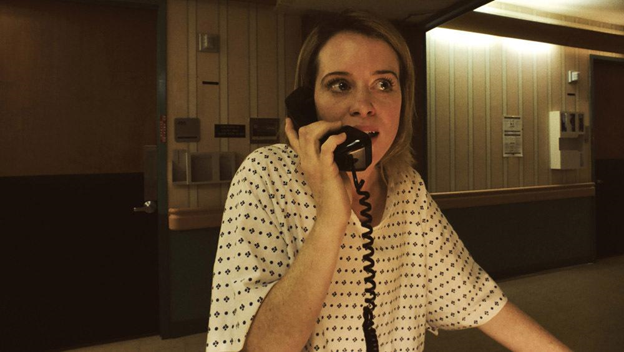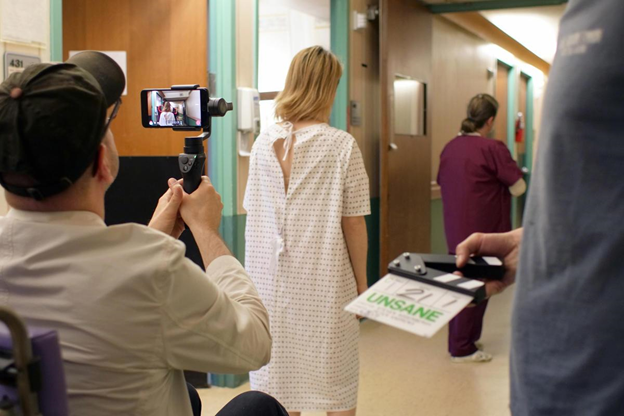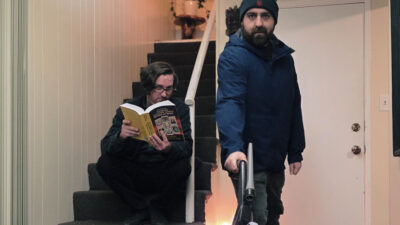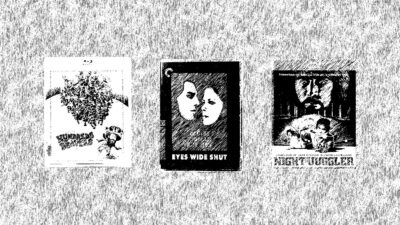This article previously appeared on Crossfader
Director: Steven Soderbergh
Genre: Thriller, Psychological Horror
Year: 2018
Monday, 9:15 PM. Movie night. My friend was vehemently opposed to watching the kid-friendly, stop-motion-animated ISLE OF DOGS, while I was (and remain) not at all in the mood for whatever the hell it is PACIFIC RIM: UPRISING is trying to sell. Obviously, a thriller about an institutionalized woman hunted by a relentless stalker was the compromise we reached. Having effectively evaded its meager marketing campaign, I really had no idea what I was getting into when I sat down for the night’s last screening of UNSANE. The fact that it was shot on an iPhone 7, or even that it was helmed by Steven Soderbergh, completely blindsided me, and it might just be thanks to this veil of ignorance that I had so much fun with the film, flawed as it is.
The latest entry in Soderbergh’s post-LOGAN LUCKY career, which has somehow managed to be both low-profile and prolific, follows Sawyer Valentini (Claire Foy), a woman dealing with severe anxiety over her stalker, David (Joshua Leonard). Seeking counselling at a nearby hospital, Sawyer is deceived by the staff into committing herself as a patient in the facility’s psychiatric wing. If that wasn’t horrifying enough, she discovers that David, under false credentials, has followed her and landed a job as an orderly in the ward. Trapped by an uncaring system and tracked by an obsessive predator, Sawyer struggles to regain both her freedom and her wits.

“SLEEPLESS IN THE PSYCH WARD” was an early casualty in the planning process
UNSANE is a writer’s movie if there ever was one. Despite leading with an opening act that drags its feet, the script from Jonathan Bernstein and James Greer is full of shocks, twists, and suspense. Nobody in Sawyer’s ward is really who they say they are, Sawyer included. The doctors aren’t there to help, the patients aren’t there to be cured, the sane aren’t sane, and the institutionalized know more than they let on. UNSANE’s web of intrigue imbues it with a conspiratorial air that is too often lacking beneath the horror-adjacent umbrella. The audience is given plenty of nudges early on that Sawyer may not be the most reliable narrator, but also that something sinister is undeniably afoot. The knowledge that Sawyer is in peril, coupled with the lack of clarity on what that peril is, results in a harrowing journey that left me on the edge of my seat throughout.
The excellent script is backed up by a trio of compelling performances. Foy’s thinly-disguised English accent would be a deal-breaker in practically any other role, but here it only helps sell her lack of composure as the distraught Sawyer. In contrast, Jay Pharoah provides a much-needed bastion of charm and rationality to UNSANE’s tempest of emotions as Nate, a fellow patient who helps Sawyer maneuver the tribulations of institutionalization. It’s Leonard, however, who steals the show as Sawyer’s shadow, David. Hulking and awkward, David’s overtures of being a gentle, if misunderstood, giant are undercut by his menacing physicality, and as his various masquerades as a functioning adult crumble away, it becomes hauntingly apparent that Sawyer isn’t facing a mere creepy admirer, but a covetous manchild who is one tantrum away from crushing her windpipe. While never sympathetic, Leonard’s portrayal is chilling in its authenticity.

Longshot theory: UNSANE is Soderbergh’s guerilla training manual for smartphone stalkers
If only UNSANE’s photography possessed the same clarity as the rest of the production. Soderbergh may be the bold claim king of Hollywood, even if he rarely lives up to his controversial statements. The director previously retired from film to focus on the small screen, only to return to the industry a few years after that announcement. Though he reneged on that vow, Soderbergh at least justified the effort by putting out an eclectic array of quality television, from THE KNICK to GODLESS. Now he’s saying he’s done with cameras altogether, championing the iPhone as his new muse.
I’m not sure how long Soderbergh will commit to this new tangent, and I’m even less certain that it’s one worth pursuing. UNSANE’s grainy resolution lends the movie a claustrophobic air that augments our heroine’s near-helpless predicament. To be perfectly clear, UNSANE looks exactly the way that it should, though I’m unconvinced that this is thanks not to Soderbergh’s seasoned eye for the cerebral, but a $549.99 piece of tech that was rendered obsolete before the movie even released. Soderbergh very likely could have replicated UNSANE’s aesthetic with a traditional film crew, so even though his gamble paid off here, the gimmick still comes across as the PR stunt that it is.
Ideological quibbles aside, UNSANE stands as a resounding, if somewhat accidental, victory for Soderbergh. From a nearly-miscast lead to a milieu that manages to be atmospheric almost in spite of its technical limitations, many of UNSANE’s stronger qualities are purely situational, but a solid script ensures that the final product remains downright riveting. UNSANE is a devilishly paranoid thriller, a pleasant surprise in a rocky quarter for film, and further proof of Soderbergh’s genius, even if his reasoning occasionally comes across as a little daft.
Verdict: Recommend















Comments